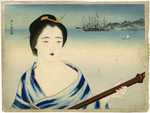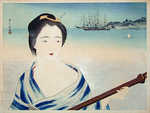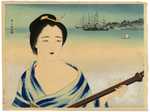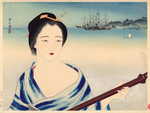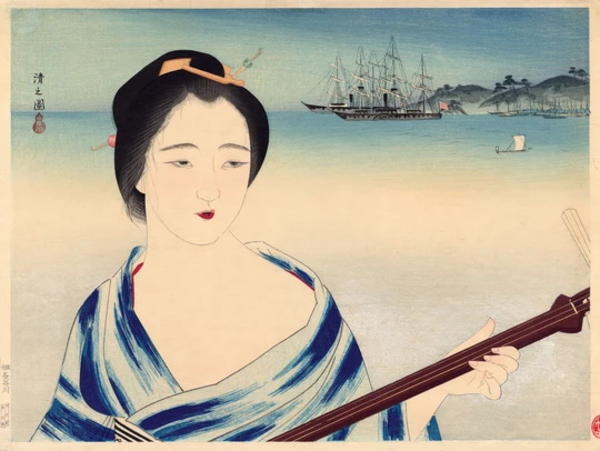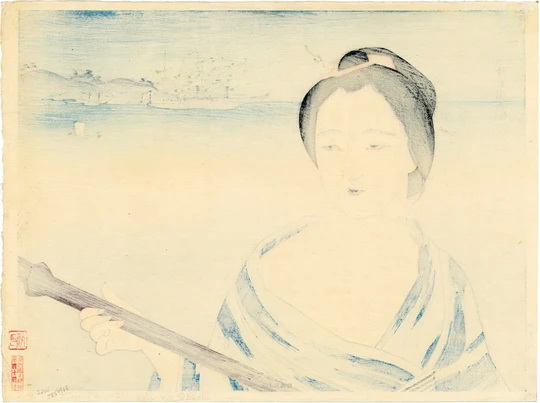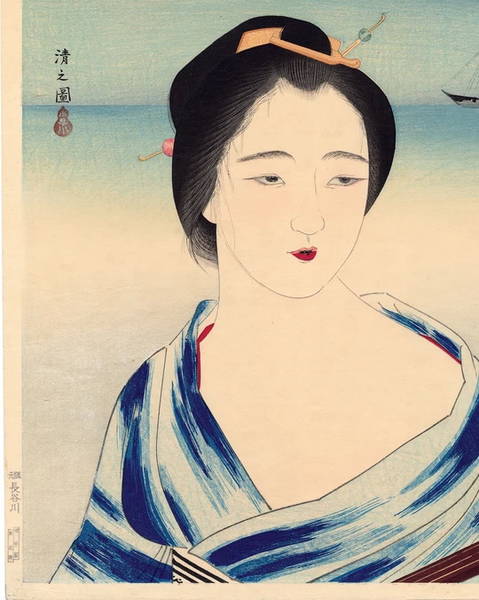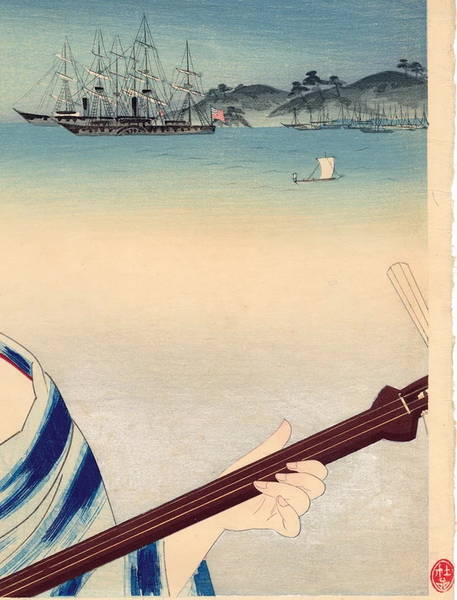| Notes (this edition)?: |
| The following information was taken from the original web listing of this artwork. Note that there may be some inaccuracies:
From https://egenolfgallery.com/products/kobayakawa-kiyoshi-the-mistress-okichi
Artist: Kobayakawa Kiyoshi
Title: The Mistress Okichi
Date: 1932
The Mistress Okichi (of Townsend Harris) (Tojin Okichi). Townsend Harris was America’s first diplomat to Japan, appointed consul by President Pierce in 1855, and he traveled to Edo in 1857. There is a popular legend that Harris had a relationship with a Japanese geisha named Okichi-san, although most historians agree that a love affair did not occur. There was a 1958 John Huston movie with John Wayne made on the subject, called The Barbarian and the Geisha. Even if this specific westerner did not have an affair with this specific geisha, the story resonated with the Japanese because this must have been quite a common occurrence. Kiyoshi was interested in depictions of women that departed from the ordinary, and here he again departs from convention. We see Okichi in a loose robe, playing her shamisen, with moored Black Ships with an American flags seen in the distance. Her face is difficult to read, but seems to portray mixed emotions. With mica in the background and blindprinting on her obi, this design presents a fascinating mix of history and culture. With a limited edition seal, verso, with the seal “Kiyoshi Kobayakawa” above edition number 44/100. Tobin collection seal, recto, lower right. Extremely scarce design.
Condition: Excellent impression, color and condition.
Dimensions: 33 x 44.3 cm
Literature: See “The female image”, fig. 1197, page 147.
Seal: Kobayakawa Publisher: Hasegawa
Signature: Kiyoshi no zu |
|
| Artist Bio: |
Kobayakawa Kiyoshi is best known for designing woodblock prints of modern Japanese women. Born in Hakata, a town in the Fukuoka Province of Kyushu, Kiyoshi was one of many artists who studied with Kaburagi Kiyokata, the famous painter and print designer. Kiyoshi entered Kiyokata's school at age twenty and probably knew Kiyokata's other students including Ito Shinsui, Kawase Hasui, and Torii Kotondo. Unfortunately, little is known about Kiyoshi's life compared to those other print designers. During the 1920's and 1930's, he exhibited Nihonga (Japanese-style) paintings at several exhibitions including the Kyodokai and the Imperial Academy Exhibition. In 1923, he contributed a print design to the series, "Complete Collection of Chikamatsu". This was probably Kiyoshi's first experience designing woodblock prints. Beginning in 1930, Kiyoshi began designing a series of six bijin prints which he called "Modern Fashionable Styles" (Kindai jisei sho). These prints were carved by Tadano Shichinosuke and printed by Ono Tomisaburo. The prints in this series were (1) Tipsy, (2) Powdering the Face, (3) Pedicure, (4) Expression of Eyes, (5) Black Hair, and (6) Rouge. Though most of these prints depict Japanese women engaged in traditional feminine pursuits, Tipsy is remarkable for its frank portrayal of a modern girl, or moga. It depicts a Japanese woman dressed in fashionable Western clothing and jewelry, drinking and smoking a cigarette. Her flirtatious, blurred gaze and her flushed cheeks indicate that she is intoxicated. This print was considered quite risque when it was first published. Kiyoshi designed thirteen prints in all, twelve of which were exhibited at the 1936 Toledo Exhibition. In addition to his six self-published prints, three were published by Hasegawa, three by Ensendo (Takamizawa) and one by Watanabe Shozaburo. Kiyoshi was awarded the special rank of Tokusen for his 1933 print, The Geisha Ichimaru. He died in April 1948 at Ikegami, Tokyo. Some of his woodblocks have been reprinted since his death and have later publisher's seals in the margin. Kobayakawa Kiyoshi is best known for designing woodblock prints of modern Japanese women. Born in Hakata, a town in the Fukuoka Province of Kyushu, Kiyoshi was one of many artists who studied with Kaburagi Kiyokata, the famous painter and print designer. Kiyoshi entered Kiyokata's school at age twenty and probably knew Kiyokata's other students including Ito Shinsui, Kawase Hasui, and Torii Kotondo. Unfortunately, little is known about Kiyoshi's life compared to those other print designers. During the 1920's and 1930's, he exhibited Nihonga (Japanese-style) paintings at several exhibitions including the Kyodokai and the Imperial Academy Exhibition. In 1923, he contributed a print design to the series, "Complete Collection of Chikamatsu". This was probably Kiyoshi's first experience designing woodblock prints. Beginning in 1930, Kiyoshi began designing a series of six bijin prints which he called "Modern Fashionable Styles" (Kindai jisei sho). These prints were carved by Tadano Shichinosuke and printed by Ono Tomisaburo. The prints in this series were (1) Tipsy, (2) Powdering the Face, (3) Pedicure, (4) Expression of Eyes, (5) Black Hair, and (6) Rouge. Though most of these prints depict Japanese women engaged in traditional feminine pursuits, Tipsy is remarkable for its frank portrayal of a modern girl, or moga. It depicts a Japanese woman dressed in fashionable Western clothing and jewelry, drinking and smoking a cigarette. Her flirtatious, blurred gaze and her flushed cheeks indicate that she is intoxicated. This print was considered quite risque when it was first published. Kiyoshi designed thirteen prints in all, twelve of which were exhibited at the 1936 Toledo Exhibition. In addition to his six self-published prints, three were published by Hasegawa, three by Ensendo (Takamizawa) and one by Watanabe Shozaburo. Kiyoshi was awarded the special rank of Tokusen for his 1933 print, The Geisha Ichimaru. He died in April 1948 at Ikegami, Tokyo. Some of his woodblocks have been reprinted since his death and have later publisher's seals in the margin.
|
|



